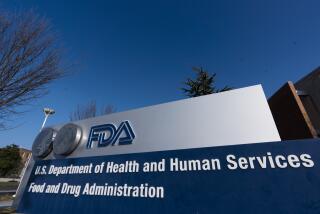FDA approves gene therapy to fix mutations that can lead to blindness
- Share via
In a decision that accelerates a new era for gene therapy, the Food and Drug Administration on Tuesday approved a DNA-altering medication that can reverse an inherited form of progressive blindness.
The FDA’s blessing makes Luxturna, a treatment for retinal dystrophy caused by a specific genetic mutation, the first gene therapy cleared for use in the U.S. to treat a genetic disease other than cancer.
Tuesday’s announcement marks the third time in five months that the drug safety agency has allowed a gene therapy — a form of treatment with a long and fitful safety history — on the U.S. market. The first approval went to Kymriah, which treats a form of leukemia, in August. In October, the drug agency cleared a second gene-based treatment called Yescarta to treat a form of lymphoma.
“Gene therapy will become a mainstay in treating, and maybe curing, many of our most devastating and intractable illnesses,” Dr. Scott Gottlieb, the FDA’s commissioner, said Tuesday. “We’re at a turning point when it comes to this novel form of therapy.”
The agency will release guidelines in the coming year to speed the evaluation and approval of additional gene therapy treatments for a range of diseases so that the country may “capitalize on this scientific opening,” he added. Among other things, the guidelines will include new ways to measure whether a gene therapy is working.
The newest gene therapy, known to scientists as voretigene neparvovec-rzyl, will be used to treat children and adults with an inherited form of vision loss. It often begins in childhood or adolescence and progresses to complete blindness in adulthood.
Between 1,000 and 2,000 people in the United States have inherited two faulty copies of the RPE65 gene, one from each parent. Luxturna replaces those faulty genes with normal versions, thus erasing the mutations’ harmful effects.
Luxturna’s safety was established in a clinical development program that tested the treatment on 41 patients between the ages of 4 and 44, the FDA said. Among the most common side effects were eye redness, cataracts, increased pressure within the eye and retinal tears.
In a yearlong clinical trial with 31 subjects affected by this form of retinal dystrophy, those treated with Luxturna showed greater improvements in their ability to navigate an obstacle course in low light compared with untreated subjects in the control group.Treatment with Luxturna must be done separately in each eye on separate days, with at least six days between surgical procedures.
It is still unclear how long the effects of a single treatment will last.
This one-shot restoration of lost vision is likely to come at a high price. Philadelphia-based Spark Therapeutics Inc., which will manufacture Luxturna in a high-tech facility in West Philadelphia, won’t announce how much it will charge until early January.
Its recent precedents have come with extremely high price tags. Kymriah costs around $475,000 for each patient treated, and the list price of Yescarta is $373,000.
Financial analysts expect Luxturna to generate annual sales of about $478 million, according to data released by Thomson Reuters.
An eye surgeon administers the treatment by injecting it into the sub-retinal portion of the eye. The normal human RPE65 gene is ferried into a patient’s retinal cells by a common cold virus that has been genetically engineered so that it can’t make patients sick.
If patients still have some viable retinal cells, the treatment restores production of a protein that converts light to an electrical signal in the retina.
The new treatment, which benefited from several FDA programs designed to streamline the drug evaluation and approval process, is the first gene therapy to use an “adeno-associated virus” as a means of transporting corrective genetic instructions into malfunctioning cells. Spark Therapeutics said it plans to conduct a post-marketing observational study to further evaluate Luxturna’s long-term safety.
Until recently, using a virus to ferry gene therapies to their targets has caused death and illness in patients — and doomed many early efforts to failure. But with advances in genetic engineering, viruses now appear able to transport gene therapies without introducing infections. That has made “Gene Therapy 2.0” one of MIT Technology Review’s “Ten Breakthrough Technologies” of 2017.
Jeffrey D. Marrazzo, chief executive officer of Spark Therapeutics, called Luxturna’s approval “a moment decades in the making for the field of gene therapy,” as well as for those who have and who treat inherited forms of retinal disease.
The company is also developing gene therapies to treat hemophilia and neurodegenerative diseases.
After climbing as high as $52.39, shares of Spark Therapeutics fell 11 cents to close at $48.94 in Nasdaq trading Tuesday.
MORE IN SCIENCE
Rich people experience happiness in a more self-centered way than poor people, study suggests
Preventing dementia: the promising, the disappointing and the inconclusive
Scientists find a miniature version of our solar system, with eight planets and a sun-like star







